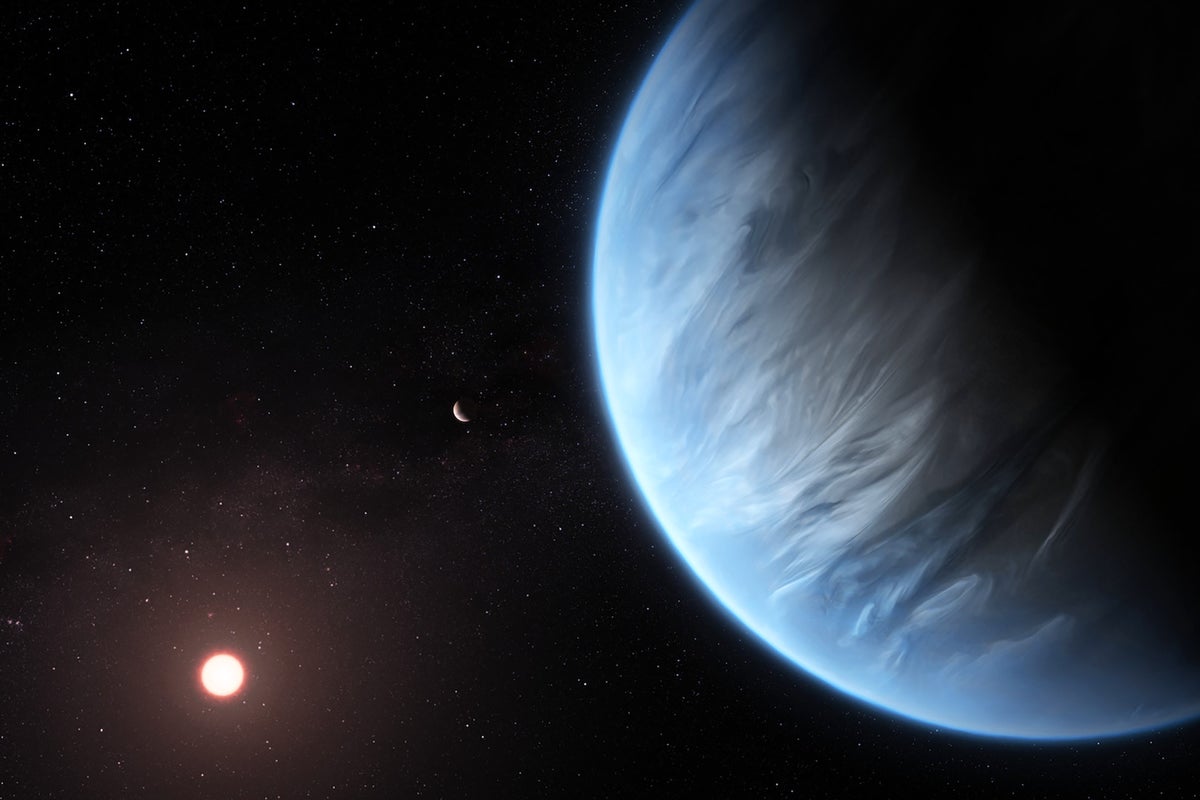Federal Budget Cuts Would Sabotage NASA’s Plans to Find Alien Life
An artist’s illustration of a potentially habitable exoplanet orbiting a red dwarf star.
We’ve never been so close to discovering life beyond Earth. Our generation could be the one that finds it—provided two essential ingredients exist. First, that there’s life out there. Second, that we’re willing to look.
Alien life’s existence is outside our control, but the universe seems to encourage our attention. Many people rest their optimism about alien life on the remarkable fact that our cosmos is brimming with planetary possibilities. To date, we’ve discovered nearly 6,000 exoplanets, most of them around only the nearest of the Milky Way’s hundreds of billions of stars. That means all our astonishingly successful planet-hunting surveys have studied just a mere teardrop of a vast cosmic sea—and implies there are at least as many planets as stars in our galaxy alone, plus some 1025 worlds in the rest of the observable universe. Chances are we’re not alone—so long as the probability that planets spring forth life is not astronomically miniscule.
Discovering alien life, on the other hand, rests squarely on us. For the first time in human history, we can meaningfully answer once-timeless questions. Countless generations before us could only ask “Are we alone?” as passive stargazers. Today our rockets reliably reach otherworldly destinations, our robotic emissaries yield transformative knowledge about our planetary neighbors, and our telescopes gaze ever farther into the heavens, revealing the subtle beauty of the cosmos.
If you’re enjoying this article, consider supporting our award-winning journalism by subscribing. By purchasing a subscription you are helping to ensure the future of impactful stories about the discoveries and ideas shaping our world today.
NASA has led the way on this work, but it now faces an existential threat in the form of short-sighted budget cuts proposed by the White House. If passed into law by Congress, these cuts would axe critical space missions, gut NASA’s workforce, and abandon one of the most captivating quests in all of science. Additional sweeping cuts planned for the National Science Foundation would be similarly ruinous for ground-based astronomy and a host of other endeavors that support NASA’s work at the high frontier.
Besides our own familiar Earth, Mars isn’t the only promising incubator of life around the sun. In the outer solar system, NASA’s Galileo probe and Cassini orbiter lifted the icy veils of Jupiter’s moon Europa and Saturn’s moon Enceladus, respectively. Beneath thick shells of ice, both moons harbor global subsurface oceans, which could be teeming with bacterial or even macroscopic denizens. NASA’s Clipper spacecraft launched in 2024 and is hurtling toward Europa, where it will make close flybys of the moon to assess its habitability. The agency has developed concepts for follow-on missions to land on both worlds and taste the chilly chemistry there for the telltale signs of life.
And then there’s the great expanse of exoplanets. NASA’s James Webb Space Telescope has furnished unprecedented data about exoplanet atmospheres, most of them hot and puffy—the easiest to observe. But the most alluring exoplanets for astrobiologists—those the size and temperature of Earth—are just beyond our sight. Currently, teams of scientists are conceptualizing NASA’s next great eye in space, the Habitable Worlds Observatory, whose mission is as its name suggests: to image and examine dozens of notionally Earth-like planets for the global exhalations of alien biospheres.
Taken together, these recent developments mean we could be at the doorstep of the next Copernican revolution, the next paradigm shift, the next epoch of human discovery.
But the president’s recently proposed budget for the 2026 federal fiscal year strikes NASA’s Science Mission Directorate with a devastating 47 percent cut. Many of the boldest, most transformative space missions will be on the chopping block if the proposal passes. It specifically defunds the Mars Sample Return project, a cancellation that would squander billions of dollars and decades of investment. It also cancels the upcoming missions to Venus, which would investigate how the only other Earth-sized planet in our solar system turned out so drastically different from our own. And it scraps the launch of the already-built Nancy Grace Roman Space Telescope, a project which among other things is essential to future exoplanet investigations; the loss of Roman would render prospects for the Habitable Worlds Observatory perilously dim. Also at grave risk are funding sources for brilliant early-career scientists working to make astrobiology’s future as bright as can be.
NASA simply cannot continue its trend of breakthrough discoveries on only half its present budget. As talent departs the U.S. and organizational memory fades, brain drain will doom its global leadership in space science in what experts have called an “extinction-level event.”
So, we must choose to do astrobiology. That means you, dear reader, have the power to influence this field’s fate. Whether through contacting elected officials, informing your friends and family about NASA’s precarious position, or simply sharing your love for space exploration, your actions can make a difference in humanity’s search for life in the universe.
Worst of all, we wouldn’t even know what we’d be missing.
This is an opinion and analysis article, and the views expressed by the author or authors are solely their own and not those of any organization they are affiliated with or necessarily those of Scientific American.
Source: www.scientificamerican.com
